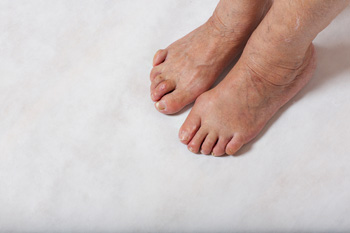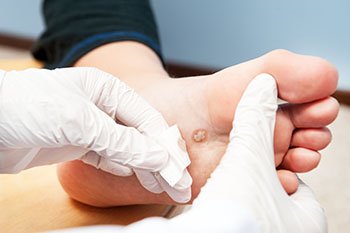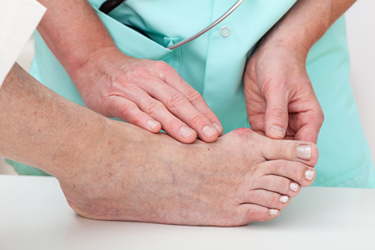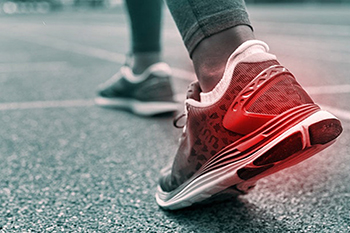Blog

Many people take their feet for granted, even though they are the foundation of the body. The feet will feel better when everyday foot care methods are routinely applied, which can begin with washing and drying the feet thoroughly. This can be followed by using a good moisturizer and trimming the toenails once per week. It is beneficial to cut the toenails straight across instead of in a curved fashion, and this may be helpful in preventing an ingrown toenail from developing. When the skin on the feet is regularly exfoliated, the removal of dead skin can make them feel softer. Exfoliating can be accomplished using a pumice stone, and it can help to soak the feet in warm water before beginning this procedure. It is beneficial to wear shoes that fit correctly, which can help to prevent several uncomfortable foot conditions from developing. If you would like more information about successful everyday foot care tips, it is suggested that you confer with a podiatrist who can provide you with the knowledge you are seeking.
Everyday foot care is very important to prevent infection and other foot ailments. If you need your feet checked, contact one of our podiatrists from Westside Podiatry Center, LLP. Our doctors can provide the care you need to keep you pain-free and on your feet.
Everyday Foot Care
Often, people take care of their bodies, face and hair more so than they do for their feet. But the feet are a very important aspect of our bodies, and one that we should pay more attention to. Without our feet, we would not be able to perform most daily tasks.
It is best to check your feet regularly to make sure there are no new bruises or cuts that you may not have noticed before. For dry feet, moisturizer can easily be a remedy and can be applied as often as necessary to the affected areas. Wearing shoes that fit well can also help you maintain good foot health, as well as making it easier to walk and do daily activities without the stress or pain of ill-fitting shoes, high heels, or even flip flops. Wearing clean socks with closed shoes is important to ensure that sweat and bacteria do not accumulate within the shoe. Clean socks help to prevent Athlete’s foot, fungi problems, bad odors, and can absorb sweat.
If you have any questions please feel free to contact one of our offices located in Liverpool, Camillus, Skaneateles, Oswego, and Cicero, NY . We offer the newest diagnostic and treatment technologies for all your foot and ankle needs.

A hammertoe is a toe deformity where the toe is bent downward at the joint, resembling a hammer. This can happen in children because of a congenital disability, wearing shoes that do not fit well, or pressure from a bunion. Buying comfortable shoes with the right size and a wide enough toe box for the toes to spread out is critical. Using a corn pad to protect the hammertoe can help relieve pressure and discomfort from friction within shoes. A child with a hammertoe can also benefit from stretching their toe muscles throughout the day. It is important to treat this condition in children to prevent future foot problems. If your child has a hammertoe, it is strongly suggested that you visit a podiatrist who can provide a plan of treatment to ease pain, correct the deformity, and protect their feet from developing further issues.
Hammertoe
Hammertoes can be a painful condition to live with. For more information, contact one of our podiatrists from Westside Podiatry Center, LLP. Our doctors will answer any of your foot- and ankle-related questions.
Hammertoe is a foot deformity that affects the joints of the second, third, fourth, or fifth toes of your feet. It is a painful foot condition in which these toes curl and arch up, which can often lead to pain when wearing footwear.
Symptoms
- Pain in the affected toes
- Development of corns or calluses due to friction
- Inflammation
- Redness
- Contracture of the toes
Causes
Genetics – People who are genetically predisposed to hammertoe are often more susceptible
Arthritis – Because arthritis affects the joints in your toes, further deformities stemming from arthritis can occur
Trauma – Direct trauma to the toes could potentially lead to hammertoe
Ill-fitting shoes – Undue pressure on the front of the toes from ill-fitting shoes can potentially lead to the development of hammertoe
Treatment
Orthotics – Custom made inserts can be used to help relieve pressure placed on the toes and therefore relieve some of the pain associated with it
Medications – Oral medications such as anti-inflammatories or NSAIDs could be used to treat the pain and inflammation hammertoes causes. Injections of corticosteroids are also sometimes used
Surgery – In more severe cases where the hammertoes have become more rigid, foot surgery is a potential option
If you have any questions please contact one of our offices located in Liverpool, Camillus, Skaneateles, Oswego, and Cicero, NY . We offer the newest diagnostic and treatment technologies for all your foot and ankle needs.

Having cold feet may be a symptom of poor circulation. Feet may also become numb and discolored, and there are various reasons for this condition to happen. Existing medical ailments, such as Raynaud’s disease may lead to developing poor circulation. Having acrocyanosis, which turns the feet or toes blue, may be another reason for this to occur. This condition can cause the blood vessels to constrict, and blood is prevented from moving through the feet. Patients who have diabetes often have poor circulation, and immediate medical attention is often sought that may help to prevent diabetic foot ulcers from developing. Additionally, smoking, high blood pressure and elevated cholesterol levels may cause poor circulation. There are methods that can be implemented which may help to reduce the risk. These can include performing breathing exercises, practicing meditation, and yoga, in addition to avoiding alcohol and caffeine. If you have symptoms of poor circulation, it is suggested that you confer with a podiatrist who can properly treat this condition.
Poor circulation is a serious condition and needs immediate medical attention. If you have any concerns with poor circulation in your feet contact one of our podiatrists of Westside Podiatry Center, LLP. Our doctors will treat your foot and ankle needs.
Poor Circulation in the Feet
Poor blood circulation in the feet and legs is can be caused by peripheral artery disease (PAD), which is the result of a buildup of plaque in the arteries.
Plaque buildup or atherosclerosis results from excess calcium and cholesterol in the bloodstream. This can restrict the amount of blood which can flow through the arteries. Poor blood circulation in the feet and legs are sometimes caused by inflammation in the blood vessels, known as vasculitis.
Causes
Lack of oxygen and oxygen from poor blood circulation restricts muscle growth and development. It can also cause:
- Muscle pain, stiffness, or weakness
- Numbness or cramping in the legs
- Skin discoloration
- Slower nail & hair growth
- Erectile dysfunction
Those who have diabetes or smoke are at greatest risk for poor circulation, as are those who are over 50. If you have poor circulation in the feet and legs it may be caused by PAD and is important to make changes to your lifestyle in order to reduce risk of getting a heart attack or stroke. Exercise and maintaining a healthy lifestyle will dramatically improve conditions.
As always, see a podiatrist as he or she will assist in finding a regimen that suits you. A podiatrist can also prescribe you any needed medication.
If you have any questions please feel free to contact one of our offices located in Liverpool, Camillus, Skaneateles, Oswego, and Cicero, NY . We offer the newest diagnostic and treatment technologies for all your foot and ankle needs.

A seed wart can result when an individual comes into direct contact with the human papillomavirus, or HPV. This skin growth can be quite unsightly and typically forms on the bottom, or sole, of the foot. They are characterized by the presence of very small black dots, known as seeds, in the center of the wart. Interestingly, these seeds are not really seeds in the traditional use of the word. Rather, these seeds are actually just tiny blood vessels that have become clotted. Therefore, although these tiny dots might look like seeds, they are in fact just blood vessels. The virus that causes seed warts is extremely contagious and can be spread by skin-to-skin contact and by other means. If you are someone that may have a seed wart, it is strongly suggested that you schedule an appointment with a podiatrist as quickly as possible who can analyze and address your foot problem.
Plantar warts can be very uncomfortable. If you need your feet checked, contact one of our podiatrists from Westside Podiatry Center, LLP. Our doctors will assist you with all of your foot and ankle needs.
About Plantar Warts
Plantar warts are the result of HPV, or human papillomavirus, getting into open wounds on the feet. They are mostly found on the heels or balls of the feet.
While plantar warts are generally harmless, those experiencing excessive pain or those suffering from diabetes or a compromised immune system require immediate medical care. Plantar warts are easily diagnosed, usually through scraping off a bit of rough skin or by getting a biopsy.
Symptoms
- Lesions on the bottom of your feet, usually rough and grainy
- Hard or thick callused spots
- Wart seeds, which are small clotted blood vessels that look like little black spots
- Pain, discomfort, or tenderness of your feet when walking or standing
Treatment
- Freezing
- Electric tool removal
- Laser Treatment
- Topical Creams (prescription only)
- Over-the-counter medications
To help prevent developing plantar warts, avoid walking barefoot over abrasive surfaces that can cause cuts or wounds for HPV to get into. Avoiding direct contact with other warts, as well as not picking or rubbing existing warts, can help prevent the further spread of plantar warts. However, if you think you have developed plantar warts, speak to your podiatrist. He or she can diagnose the warts on your feet and recommend the appropriate treatment options.
If you have any questions please feel free to contact one of our offices located in Liverpool, Camillus, Skaneateles, Oswego, and Cicero, NY . We offer the newest diagnostic and treatment technologies for all your foot and ankle needs.

A bunion, termed hallux valgus, is a bone deformity of the big toe. This condition can cause the tip of the toe to push toward the smaller toes as the bottom of the toe joint juts outward from the foot. The resulting bump can prove to be painful as it changes the gait and rubs against the inside of the shoe. In some cases, a surgical procedure may be the only option for reducing pain. This may be successful in straightening out the joint, in addition to stabilizing the gait. It can also help to prevent hammertoe and other foot abnormalities from developing. Deciding on bunion surgery depends on various factors, such as the severity of the bunion, and whether it is related to osteoarthritis. Additionally, the impact it may have on completing daily activities or participating in sporting activities may contribute to making this decision. Side effects may include nerve damage, inflammation, and permanent stiffness. It is beneficial to explore this with a podiatrist before deciding on this type of surgery. To find out whether bunion surgery is the right option for you, it is suggested that you consult a podiatrist for an exam and diagnosis.
If you are suffering from bunion pain, contact one of our podiatrists of Westside Podiatry Center, LLP. Our doctors can provide the care you need to keep you pain-free and on your feet.
What Is a Bunion?
Bunions are painful bony bumps that usually develop on the inside of the foot at the joint of the big toe. As the deformity increases over time, it may become painful to walk and wear shoes. Women are more likely to exacerbate existing bunions since they often wear tight, narrow shoes that shift their toes together. Bunion pain can be relieved by wearing wider shoes with enough room for the toes.
Causes
- Genetics – some people inherit feet that are more prone to bunion development
- Inflammatory Conditions - rheumatoid arthritis and polio may cause bunion development
Symptoms
- Redness and inflammation
- Pain and tenderness
- Callus or corns on the bump
- Restricted motion in the big toe
In order to diagnose your bunion, your podiatrist may ask about your medical history, symptoms, and general health. Your doctor might also order an x-ray to take a closer look at your feet. Nonsurgical treatment options include orthotics, padding, icing, changes in footwear, and medication. If nonsurgical treatments don’t alleviate your bunion pain, surgery may be necessary.
If you have any questions, please feel free to contact one of our offices located in Liverpool, Camillus, Skaneateles, Oswego, and Cicero, NY . We offer the newest diagnostic and treatment technologies for all your foot care needs.

The most common cause of blisters on the foot is friction, usually between the foot and the shoe. Damage to the top skin layer can cause it to separate, leaving space for fluid to protect the underlying layers. Walking in tight shoes or wearing shoes without socks are common causes of friction blisters. They are nature’s way of protecting skin that is in danger of being damaged. Most friction blisters do not need medical attention, and if protected by a bandage, they will likely heal on their own in a few days. However, if a blister becomes infected, this may cause redness and swelling, and the blister may fill with pus or blood rather than a clear fluid. At this point, it is wise to seek medical help from a podiatrist, who can examine the blister and offer treatment options. Certain medications and protective bandages may be prescribed. It will also be beneficial to cease wearing the shoes that caused the blister to form. For further guidance, it is suggested that you consult a podiatrist.
Blisters are prone to making everyday activities extremely uncomfortable. If your feet are hurting, contact one of our podiatrists of Westside Podiatry Center, LLP. Our doctors can provide the care you need to keep you pain-free and on your feet.
Foot Blisters
Foot blisters develop as a result of constantly wearing tight or ill-fitting footwear. This happens due to the constant rubbing from the shoe, which can often lead to pain.
What Are Foot Blisters?
A foot blister is a small fluid-filled pocket that forms on the upper-most layer of the skin. Blisters are filled with clear fluid and can lead to blood drainage or pus if the area becomes infected.
How Do Blisters Form?
Blisters on the feet are often the result of constant friction of skin and material, usually by shoe rubbing. Walking in sandals, boots, or shoes that don’t fit properly for long periods of time can result in a blister. Having consistent foot moisture and humidity can easily lead to blister formation.
Prevention & Treatment
It is important to properly care for the affected area in order to prevent infection and ease the pain. Do not lance the blister and use a Band-Aid to provide pain relief. Also, be sure to keep your feet dry and wear proper fitting shoes. If you see blood or pus in a blister, seek assistance from a podiatrist.
If you have any questions, please feel free to contact one of our offices located in Liverpool, Camillus, Skaneateles, Oswego, and Cicero, NY . We offer the newest diagnostic and treatment technologies for all your foot care needs.

Many individuals may not already be familiar with what exactly a pressure sore is. Pressure sores can develop on the skin when pressure is applied to the surface of the skin and blood flow to the skin is reduced. As a result, a sore may develop. Pressure sores can develop all throughout the body, but they can also be particularly harmful on the heels of the feet. There are four different stages of pressure sores, each increasing in severity. Podiatrists, or foot care specialists, can help identify pressure sores on your feet and effectively devise a treatment plan that best suits your needs. If you are someone who thinks that you might have a pressure sore on your feet or heel, it is highly recommended that you schedule an appointment with a podiatrist today for medical attention and potential treatment.
Wound care is an important part in dealing with diabetes. If you have diabetes and a foot wound or would like more information about wound care for diabetics, consult with one of our podiatrists from Westside Podiatry Center, LLP. Our doctors will assess your condition and provide you with quality foot and ankle treatment.
What Is Wound Care?
Wound care is the practice of taking proper care of a wound. This can range from the smallest to the largest of wounds. While everyone can benefit from proper wound care, it is much more important for diabetics. Diabetics often suffer from poor blood circulation which causes wounds to heal much slower than they would in a non-diabetic.
What Is the Importance of Wound Care?
While it may not seem apparent with small ulcers on the foot, for diabetics, any size ulcer can become infected. Diabetics often also suffer from neuropathy, or nerve loss. This means they might not even feel when they have an ulcer on their foot. If the wound becomes severely infected, amputation may be necessary. Therefore, it is of the upmost importance to properly care for any and all foot wounds.
How to Care for Wounds
The best way to care for foot wounds is to prevent them. For diabetics, this means daily inspections of the feet for any signs of abnormalities or ulcers. It is also recommended to see a podiatrist several times a year for a foot inspection. If you do have an ulcer, run the wound under water to clear dirt from the wound; then apply antibiotic ointment to the wound and cover with a bandage. Bandages should be changed daily and keeping pressure off the wound is smart. It is advised to see a podiatrist, who can keep an eye on it.
If you have any questions, please feel free to contact one of our offices located in Liverpool, Camillus, Skaneateles, Oswego, and Cicero, NY . We offer the newest diagnostic and treatment technologies for all your foot care needs.

Running and walking are popular activities that require wearing different types of shoes. Most running shoes are constructed with more cushioning than walking shoes and may be designed in brighter colors. They may have a thicker sole, and it is important not to trip. Walking shoes are made of lighter materials and can help to move the foot forward from heel to toe. People who walk will land on their heels, and walking shoes can increase stability. Race-walking may be demanding on the feet, and it is beneficial for people who enjoy this form of walking to look for a shoe with adequate flexibility. If you would like more information about the differences between walking and running shoes, it is suggested that you speak with a podiatrist who can guide you toward the pair that is right for you.
For more information about walking shoes versus running shoes, consult with one of our podiatrists from Westside Podiatry Center, LLP. Our doctors can measure your feet to determine what your needs are and help you find an appropriate pair of footwear.
Foot Health: The Differences between Walking & Running Shoes
There are great ways to stay in shape: running and walking are two great exercises to a healthy lifestyle. It is important to know that running shoes and walking shoes are not interchangeable. There is a key difference on how the feet hit the ground when someone is running or walking. This is why one should be aware that a shoe is designed differently for each activity.
You may be asking yourself what the real differences are between walking and running shoes and the answers may shock you.
Differences
Walking doesn’t involve as much stress or impact on the feet as running does. However, this doesn’t mean that you should be any less prepared. When you’re walking, you land on your heels and have your foot roll forward. This rolling motion requires additional support to the feet.
Flexibility – Walking shoes are designed to have soft, flexible soles. This allows the walker to push off easily with each step.
If you have any questions, please feel free to contact one of our offices located in Liverpool, Camillus, Skaneateles, Oswego, and Cicero, NY . We offer the newest diagnostic and treatment technologies for all your foot care needs.
Blog Archives
- 2024
- 2023
- 2022
- 2021
- 2020
- 2019
- 2018
- 2017


